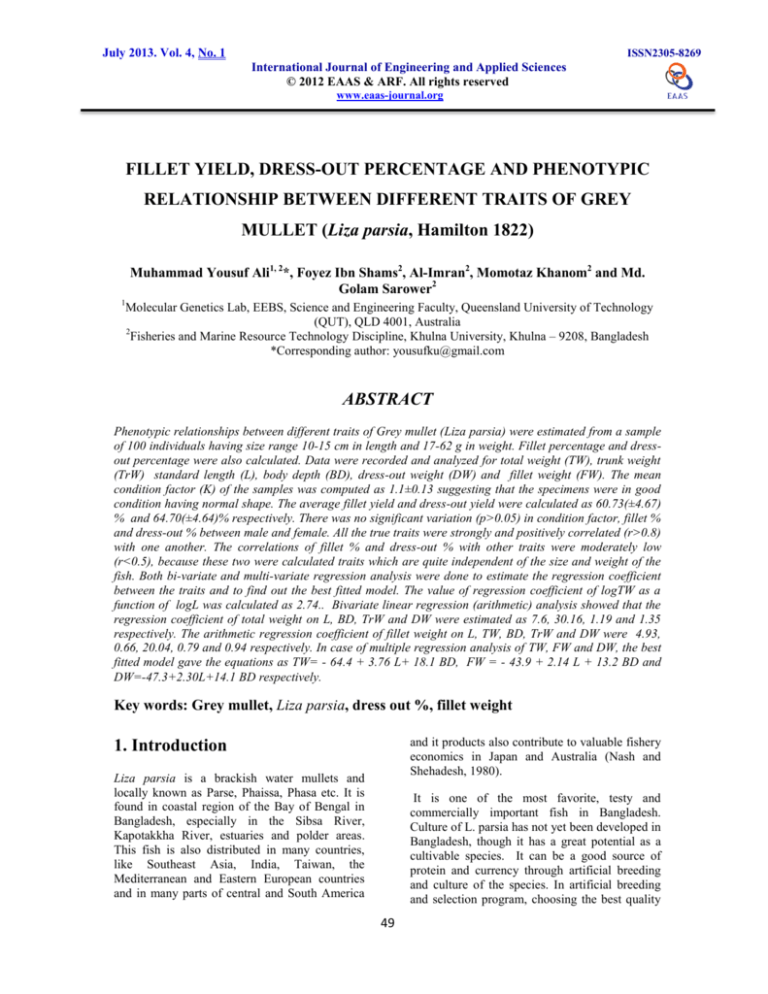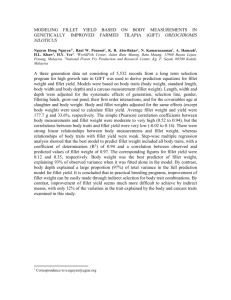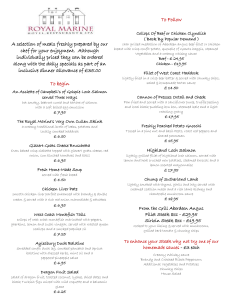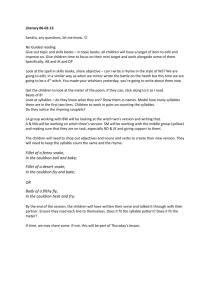
July 2013. Vol. 4, No. 1
ISSN2305-8269
International Journal of Engineering and Applied Sciences
© 2012 EAAS & ARF. All rights reserved
www.eaas-journal.org
FILLET YIELD, DRESS-OUT PERCENTAGE AND PHENOTYPIC
RELATIONSHIP BETWEEN DIFFERENT TRAITS OF GREY
MULLET (Liza parsia, Hamilton 1822)
Muhammad Yousuf Ali1, 2*, Foyez Ibn Shams2, Al-Imran2, Momotaz Khanom2 and Md.
Golam Sarower2
1
Molecular Genetics Lab, EEBS, Science and Engineering Faculty, Queensland University of Technology
(QUT), QLD 4001, Australia
2
Fisheries and Marine Resource Technology Discipline, Khulna University, Khulna – 9208, Bangladesh
*Corresponding author: yousufku@gmail.com
ABSTRACT
Phenotypic relationships between different traits of Grey mullet (Liza parsia) were estimated from a sample
of 100 individuals having size range 10-15 cm in length and 17-62 g in weight. Fillet percentage and dressout percentage were also calculated. Data were recorded and analyzed for total weight (TW), trunk weight
(TrW) standard length (L), body depth (BD), dress-out weight (DW) and fillet weight (FW). The mean
condition factor (K) of the samples was computed as 1.1±0.13 suggesting that the specimens were in good
condition having normal shape. The average fillet yield and dress-out yield were calculated as 60.73(±4.67)
% and 64.70(±4.64)% respectively. There was no significant variation (p>0.05) in condition factor, fillet %
and dress-out % between male and female. All the true traits were strongly and positively correlated (r>0.8)
with one another. The correlations of fillet % and dress-out % with other traits were moderately low
(r<0.5), because these two were calculated traits which are quite independent of the size and weight of the
fish. Both bi-variate and multi-variate regression analysis were done to estimate the regression coefficient
between the traits and to find out the best fitted model. The value of regression coefficient of logTW as a
function of logL was calculated as 2.74.. Bivariate linear regression (arithmetic) analysis showed that the
regression coefficient of total weight on L, BD, TrW and DW were estimated as 7.6, 30.16, 1.19 and 1.35
respectively. The arithmetic regression coefficient of fillet weight on L, TW, BD, TrW and DW were 4.93,
0.66, 20.04, 0.79 and 0.94 respectively. In case of multiple regression analysis of TW, FW and DW, the best
fitted model gave the equations as TW= - 64.4 + 3.76 L+ 18.1 BD, FW = - 43.9 + 2.14 L + 13.2 BD and
DW=-47.3+2.30L+14.1 BD respectively.
Key words: Grey mullet, Liza parsia, dress out %, fillet weight
and it products also contribute to valuable fishery
economics in Japan and Australia (Nash and
Shehadesh, 1980).
1. Introduction
Liza parsia is a brackish water mullets and
locally known as Parse, Phaissa, Phasa etc. It is
found in coastal region of the Bay of Bengal in
Bangladesh, especially in the Sibsa River,
Kapotakkha River, estuaries and polder areas.
This fish is also distributed in many countries,
like Southeast Asia, India, Taiwan, the
Mediterranean and Eastern European countries
and in many parts of central and South America
It is one of the most favorite, testy and
commercially important fish in Bangladesh.
Culture of L. parsia has not yet been developed in
Bangladesh, though it has a great potential as a
cultivable species. It can be a good source of
protein and currency through artificial breeding
and culture of the species. In artificial breeding
and selection program, choosing the best quality
49
July 2013. Vol. 4, No. 1
ISSN2305-8269
International Journal of Engineering and Applied Sciences
© 2012 EAAS & ARF. All rights reserved
www.eaas-journal.org
and healthy parents is a major concern. For
selection of the parents for next generation, some
traits are economically important such as higher
weight, length, fillet percentage and dress-out
percentage. Though fillet percentage and dressout percentage are the most important and
targeted traits, it can not be measured without
slaughtering the fish. Thus it is a problem to
directly estimate fillet percentage and dress-out
percentage. The alternative way is to use the
correlation between other traits that can be
measured easily such as length, weight, body
depth etc. For this reason, it is very important to
know the relationships between different traits.
whether the fish was male or female. Out of total
size 100, 50 were identified as male and 50 as
female.
2.3. Data collection and measurement:
Data were recorded on the traits Total weight
(TW), Standard length (SL), Body depth (BD),
Head length (HL), Head weight (HW), Dress-out
weight (DW) and Fillet weight (FW). Dress-out
percentage, fillet percentage and coefficient of
condition (K) were also calculated.
Standard length (SL) was measured as the length
from the tip of the snout to the posterior end of
the last vertebra or to the posterior end of the
midlateral portion of the hypural plate. Simply,
this measurement excludes the length of the
caudal fin.
Many works have been conducted on the
relationships between different traits, especially
length-weight, in many fishes (Gonçalves et al.,
1996; Haddon et al., 1995; O’Reilly et al., 2004;
Schweigert et al., 1990; Shao et al., 2007;
Soranganba et al., 2007)) . However, this type of
work is rare in L. parsia. That is why the present
investigation was carried out on phenotypic
relationship between some economically
important traits of Liza parsia and to find out the
best-fitted model that express the relationships
between the traits with high accuracy.
2.
MATERIALS
Dress-out percentage was calculated as:(the
weight of the fish without head, viscera, and
skin/divided by total weight) x100 %
Fillet percentage was calculated as:{the weight of
muscle (removed with an sharp knife from the
vertebra of the dressed fish)/divided by total
weight} x100 %
AND
The coefficient of condition or condition factor of
the fish was measured by the formula,
K=W/L3×100
METHODS
Where: W = the weight of the fish in
grams; L = the standard length of the fish in
centimeters.
2.1. Sample collection:
The study was conducted in April of 2011. A
total of 100 fishes were collected as sample.
Samples of L. parsia were collected directly from
the different local market of Khulna region. After
collection, samples were brought immediately to
the Fish Biology laboratory of Fisheries and
Marine Resource Technology Discipline, Khulna
University. The samples were kept as fresh
condition without icing or freezing.
In the laboratory important phenotypic data were
collected using different tools such as cm scale,
slide calipers, electric weight machine (Model:
AND GF-300), scissors, knife, forceps etc.
Length measurements were taken using a slide
calipers and a ruler for all individuals. Weight
was measured with 2 decimals precision by
electric weight machine of Fish Nutrition
Laboratory of Fisheries and Marine Resource
Technology Discipline. Then it was dissected by
sharp knife and scissor and weighted. Fish were
gutted in order to remove and measure the
dressing weight. The body depth was collected by
using slide calipers. Then the weight of the fish
was measured by electric weight machine of Fish
Nutrition Laboratory of Fisheries and Marine
Resource Technology Discipline. Then it was
2.2. Sex identification:
Fish were identified by using the identification
key of Soljan (1975). Sexes of all fishes of the
sample were determined by striping the bally of
fish or observing the internal sex organ. In case
of external sex determination for the reason of
striping egg for female and milt for male were
come out while in internal sex determination by
observing testis and ovary it was determined
50
July 2013. Vol. 4, No. 1
ISSN2305-8269
International Journal of Engineering and Applied Sciences
© 2012 EAAS & ARF. All rights reserved
www.eaas-journal.org
dissected by sharp knife and scissor and
weighted.
3. RESULTS AND
DISCUSSION
2.4. Data analysis and model setting:
All the data were analyzed by using statistical
software Minitab-15. Other softwares SAS 9.1
and SPSS 12.0 were used to check the
consistency of the results.
3.1. Descriptive Statistics:
The descriptive statistics of all traits are shown in
the table 1. In the present study, the mean
standard length and body depth of the samples
were found as
cm (range 9.2-15.3
cm) &
cm (range 2.4-3.7 cm).
The relationship between length (L) and weight
(W) was calculated by the equation: W=aLb
Where: W = the weight of the fish in
grams; L = the length of the fish in centimeters.
The average total weight was
g
where minimum was 17.08g and maximum was
62.11g. In case of body weight the mean was
where minimum body weight was
12.56 g and maximum 47.36g. Mean fillet weight
was
with a range of 10.00g to
38.24g. The average fillet % and dress-out %
were 60.73±4.67 and 60.73±4.67 respectively.
Mean condition factor of the samples was
1.10±0.13 (range 0.77-1.40), which shows that all
the fish had normal shape.
Values of W were calculated from the
logarithmic (base 10) equivalent: logW=loga+b
logL
For model setting bivariate regression model and
multiple regression models were used to estimate
the relationships between different traits: The
model was assumed as:
Y=a +b1X1+b2X2+b3X3+…………………+bnXn
Where: a = constant or intercept; b =
regression coefficient or the slope of the
regression curve;Y= Response variable; X =
predictable variables as X1, X2, X3……..Xn.
There was no significant difference (p>0.05) in
fillet %, dress-out % and condition factor
between male and female (result not shown).
Table 1: Sample size, mean (±standard deviation) and range of the traits.
N
Mean (±std)
Minimum
Maximum
Length (cm)
100
12.33±1.36
10.20
15.30
Total Weight (g)
100
37.15±10.91
17.08
62.11
Body Depth (cm)
100
3.06±0.34
2.40
3.70
Trunk weight (g)
100
29.59±9.16
12.56
47.36
Dress-out Weight (g)
100
24.27±7.89
10.66
40.62
Fillet Weight (g)
100
22.77±7.38
10.00
38.24
Dress-out Percentage
100
64.70±4.64
54.82
73.17
Fillet Percentage
100
60.73±4.67
51.059
70.007
Condition factor
100
1.10±0.13
0.77
1.40
Traits
51
July 2013. Vol. 4, No. 1
ISSN2305-8269
International Journal of Engineering and Applied Sciences
© 2012 EAAS & ARF. All rights reserved
www.eaas-journal.org
positively correlated (r>0.8) with one another.
The correlations of fillet % and dress-out % with
other traits were low, because these two were
calculated traits which are independent of the size
and weight of the fish.
3.2. Correlation between traits:
Phenotypic correlations among all the selected
traits are shown in the table 2. . It is evident from
the table that all the true traits were strongly and
Table 2: Correlation matrix between different traits.
Traits
Length
Total
Body
Body
Dress-out
Fillet
Dress-
Fillet
Weight
depth
Weight
Weight
Weight
out %
%
1
0.92*
0.83*
0.90*
0.89*
0.89*
0.37*
0.33*
Total Weight
0.92*
1
0.94*
0.99*
0.98*
0.97*
0.46*
0.41*
Body depth
0.83*
0.94*
1
0.95*
0.93*
0.92*
0.49*
0.44*
Trunk Weight
0.90*
0.99*
0.95*
1
0.98*
0.98*
0.51*
0.45*
Dress-out Weight
0.89*
0.98*
0.93*
0.98*
1
0.99*
0.63*
0.58*
Fillet Weight
0.89*
0.97*
0.92*
0.98*
0.99*
1
0.64*
0.60*
Dress-out %
0.37*
0.46*
0.49*
0.51*
0.63*
0.64*
1
0.98*
Fillet %
0.33*
0.41*
0.44*
0.45*
0.58*
0.60*
0.98*
1
Length
* Significant at 0.01 level (2-tailed).
about 30, which means that each 1 cm increase in
body depth will lead to 30 g increase in weight.
In the same way, model 3 shows that 1 g increase
of trunk weight lead to 1 g increase in total
weight (Model 3); model 4 shows that 1 g
increase of dress-out weight lead to 1 g increase
in total weight (Model 4). Model 5 shows that the
arithmetic regression coefficient (b) of fillet
weight as a function of length is about 5, which
means that each 1 cm increase in length will lead
to 5 g increase in fillet weight, as well as 1 cm
increase in body depth will lead to 20 g increase
in fillet weight (Model 7) and 1 g increase in
Dress-out Weight will lead to 1 g increase in
fillet weight (Model 9).For the models of dressout weight (Model 10) shows that the arithmetic
regression coefficient (b) of dress-out weight as a
function of length is about 5.3, which means that
each 1 cm increase in length will lead to 5.3 g
increase in dress-out weight. As well as 1 g
increase in trunk weight will lead to 1 g increase
in fillet weight (Model 13).
3.3. Bivariate Relationship of total
weight, fillet weight and dress-out
weight with other traits:
Bivariate relationship of total weight, fillet
weight and dress-out weight with other traits are
shown in Table 3. The fitted regression line of
total weight and fillet weight as functions of other
traits are presented in Fig. 1-14. The logarithmic
regression coefficient “b” has a value almost
equal to b =3.0. The regression equation of Total
weight (W) on Length (L) is logW=-1.4+2.74
logL (r=0.83). According to many authors ( for
example: Gonçalves et al., 1996; Soranganba et
al. 2007), b values may range from 2.5 to 3.5
suggesting that result of this study is valid. Model
1 shows that the arithmetic regression coefficient
(b) of total weight as a function of length is about
8, which means that each 1 cm increase in length
will lead to 8 g increase in weight. Model 2
shows that the arithmetic regression coefficient
(b) of total weight as a function of body depth is
52
July 2013. Vol. 4, No. 1
ISSN2305-8269
International Journal of Engineering and Applied Sciences
© 2012 EAAS & ARF. All rights reserved
www.eaas-journal.org
Table 3: Bivariate Relationship of total weight, fillet weight and dress-out weight with other traits:
Model #
Response
Predictable
variable
variable
Model 1
Total Weight(g)
Length (cm)
Model 2
Total Weight(g)
Body
r2
a
b (±se)
85%
- 56.45
7.60* (±4.25)*
TW = - 56.45 + 7.60 L
88.5%
- 55.10
30.16* (±3.73)*
TW = - 55.10 + 30.16 BD
99.0%
2.07
1.19* (±1.1)*
TW = 2.07 + 1.19 TrW
95.6%
4.30
1.35*(±1.3)*
TW = 4.30 + 1.35 DW
Regression equation
Depth(cm)
Model 3
Total Weight(g)
Trunk
Weight(g)
Model 4
Total Weight(g)
Dress-out
Weight(g)
Model 5
Fillet Wight(g)
Length (cm)
78.3%
- 38.02
4.93*(±3.45)*
FW = - 38.02 + 4.93 L
Model 6
Fillet Wight(g)
Total
94.6%
- 1.68
0.66*(±0.03)*
FW = - 1.68 + 0.66 TW
85.3%
- 38.54
20.04*(±0.05)*
FW = - 38.54 + 20.04 BD
95.9%
- 0.59
0.79*(±0.03)*
FW = - 0.59 + 0.79 TrW
99.7%
0.06
0.94*(±0.04)*
FW = 0.06 + 0.94 DW
Length (cm)
79.2%
- 41.00
5.29*(±3.61)*
DW= - 41.00 + 5.29 L
Dress-out
Total
95.6%
- 1.97
0.71*(±0.03)*
DW = - 1.97 + 0.71 TW
weight(g)
Weight(g)
Dress-out
Body
86.3%
- 41.55
21.52*(±2.93)*
DW = - 41.55 + 21.52 BD
weight(g)
Depth(cm)
Dress-out
Trunk
96.8%
- 0.79
0.85*(±0.02)*
DW = - 0.79 + 0.85TW
weight(g)
Weight(g)
Dress-out
Fillet
99.7%
- 0.01
1.07*(±0.4)*
DW = - 0.01 + 1.07 FW
weight(g)
Weight(g)
Weight(g)
Model 7
Fillet Wight(g)
Body
Depth(cm)
Model 8
Fillet Wight(g)
Trunk
Weight(g)
Model 9
Fillet Wight(g)
Dress-out
Weight(g)
Model 10
Dress-out
weight(g)
Model 11
Model 12
Model 13
Model 14
Asterisk on the coefficients indicate significant differences from zero. *p<0.01
Here, TW= Total weight, L= Length, BD= Body depth, TrW= Trunk weight and DW= Dress-out weight & FW= Fillet
weight
53
July 2013. Vol. 4, No. 1
ISSN2305-8269
International Journal of Engineering and Applied Sciences
© 2012 EAAS & ARF. All rights reserved
www.eaas-journal.org
Total Weight(g) = - 56.45 + 7.6 Length(cm)
60
Total Weight(g) = - 55.1 + 30.16 Body depth(cm)
60
50
Total Weight(g)
Total Weight(g)
50
40
30
20
R-Sq
N
10
11
12
13
Length(cm)
14
15
40
30
20
85.0%
100
2.50
50
50
Total Weight(g)
Total Weight(g)
60
40
30
20
40
3.75
30
R-Sq
N
10
15
20
25
30
Dressout Weight(g)
95.6%
100
35
40
Fig 4: Linear regression of Total wt vs. Dress-out wt
40
Fillet Weight(g) = - 38.02 + 4.932 Length(cm)
35
35
30
30
Fillet Weight(g)
Fillet Weight(g)
100
3.50
40
50
Fig 3: Linear regression of Total wt vs. Trunk wt
40
3.00
3.25
Body depth(cm)
20
R-Sq 99.0%
N
100
30
Trunk Weight(g)
2.75
Total Weight(g) = 4.3 + 1.36 Dressout Weight(g)
Total Weight(g) = 2.069 + 1.186 Trunk Weight(g)
60
20
88.5%
N
Fig 2. Linear regression of Total wt vs. Body Depth
Fig 1. Linear regression of Total wt vs. Length
10
R-Sq
16
25
20
Fillet Weight(g) = - 1.68 + 0.66 Total Weight(g)
25
20
15
15
R-Sq
N
10
10
11
12
13
Length(cm)
14
15
78.3%
100
16
R-Sq
N
10
20
30
40
Total Weight(g)
50
Fig 6: Linear regression of Fillet wt vs. Total wt
Fig 5: Linear regression of Fillet wt vs. Length
54
94.6%
100
60
July 2013. Vol. 4, No. 1
ISSN2305-8269
International Journal of Engineering and Applied Sciences
© 2012 EAAS & ARF. All rights reserved
www.eaas-journal.org
40
Fillet Weight(g) = - 38.54 + 20.04 Body depth(cm)
35
35
30
30
Fillet Weight(g)
Fillet Weight(g)
40
25
20
15
2.50
2.75
3.00
3.25
Body depth(cm)
85.3%
100
3.50
20
R-Sq
N
10
3.75
Fig 7: Linear regression of Fillet wt vs. Body Dpt.
10
20
30
Trunk Weight(g)
95.9%
100
40
50
Fig 8: Linear regression of Fillet wt vs. Trunk wt
40 Fillet Weight(g) = 0.06 + 0.93 Dressout Weight(g)
40
35
Dress-out Weight(g) = - 41.00 + 5.29 Length(cm)
35
Dress-out Weight(g)
Fillet Weight(g)
25
15
R-Sq
N
10
30
25
20
30
25
20
15
15
R-Sq
N
10
10
15
20
25
30
Dressout Weight(g)
99.7%
100
35
R-Sq
N
10
10
40
11
12
13
Length(cm)
14
79.2%
100
15
16
Fig 10: Linear regression of Dress-out wt vs. Length
Fig 9: Linear regression of Fillet wt vs. Dress-out wt
45
Fillet Weight(g) = - 0.59 + 0.79 Trunk Weight(g)
Dress-out Weight(g) = - 1.97 + 0.71 Total Weight(g)
40
Dress-out Weight(g) = - 41.55 + 21.52 Body depth(cm)
40
Dress-out Weight(g)
Dress-out Weight(g)
35
35
30
25
20
30
25
20
15
15
R-Sq
N
10
20
30
40
Total Weight(g)
50
95.6%
100
60
R-Sq
N
10
2.50
Fig 11: Linear regression of D. wt vs. T. Weight
2.75
3.00
3.25
Body depth(cm)
3.50
Fig 12: Linear regression of D. wt vs. Body Dpt.
55
86.3%
100
3.75
July 2013. Vol. 4, No. 1
ISSN2305-8269
International Journal of Engineering and Applied Sciences
© 2012 EAAS & ARF. All rights reserved
www.eaas-journal.org
40
Dress-out Weight(g) = - 0.79 + 0.85 Trunk Weight(g)
40
35
Dress-out Weight(g)
Dress-out Weight(g)
35
Dress-out Weight(g) = - 0.01 + 1.07 Fillet Weight(g)
30
25
20
15
30
25
20
15
R-Sq
N
10
10
20
30
Trunk Weight(g)
96.8%
100
40
R-Sq
N
10
50
10
Fig 13: Linear regression of D. wt vs. Trunk wt
15
20
25
Fillet Weight(g)
30
99.7%
100
35
Fig 14: Linear regression of D. wt vs. Fillet wt
provide more accurate result then the bivariate
relationship. Multivariate relationship of total
weight and fillet weight with other traits are
shown in Table 4.
3.4. Multivariate Relationship of total
weight and fillet weight with other
traits:
Sometimes bivariate relationship could not show
the accurate result. Multivariate relationship can
Table 4: Multivariate Relationship of total weight and fillet weight with other traits
Model #
Response
Predictable
Variable
r2
a
b
Fitted regression equation
Variable
Fillet Weight
Model 15
Model 16
2.14*
Length
90.0%
Total Weight
- 43.9
13.2*
Length
3.76*
95.1%
- 64.4
Dress-out
Weight
TW= - 64.4 + 3.76 L+ 18.1 BD
18.1*
Body Depth
Model 17
FW = - 43.9 + 2.14 L + 13.2 BD
Body Depth
Total Weight
0.71
95.7%
DW = - 1.76 + 0.71 TW - 0.36 L + 1.38 BD
- 1.76
Length
- 0.36
Body Depth
1.38
Asterisk on the coefficients indicate significant differences from zero.*p<0.01
From above table it is seems that the best fitted
model for the relationship measure is relation
with fillet weight with combined to length and
body depth, total weight with combined to length
and body depth and dress-out weight with
combined to total weight, length and body depth.
Fillet weight= -43.9+2.14 Length+ 13.2 Body
Depth
Total Weight= - 64.4 + 3.76 Length+ 18.1 Body
Depth
Dress-out Weight= -17.6+ 0.71 Total Weight –
0.36 Length + 1.38 Body Depth
So the best fitted models are:
56
40
July 2013. Vol. 4, No. 1
ISSN2305-8269
International Journal of Engineering and Applied Sciences
© 2012 EAAS & ARF. All rights reserved
www.eaas-journal.org
Condition factor “k” when plotted (k=W/L3×100)
against length and body weight, it was found to
remain constant with increasing length or weight.
The regression parameters of condition factor (k)
on wet body weight (w) and total length (TL) are
presented below
rapidly than cube of length, the K would increase
with increase in length. When weight increases
less than the cube of length, K would tend to
decrease with the growth of the fish.
3.5. Practical Conversion Table for
Important traits:
Condition Factor (K) = 1.048 + 0.004456 Length
(r2=0.2)
Here are two conversions shown in table 5 which
were made by using the best fitted bivariate
relationship of length and body depth with total
weight and fillet weight. From the table it seems
that the data is valid within the range of the
sample used for current study. As an example the
tabular value of total weight for a 15 cm length
fish is 57.6 g where the observed weight of a 15
cm length fish was 58.5 g. above or below this
point it may lead to error. For accurate results,
samples should include small to bigger sized fish
Condition Factor (K) = 0.9635 + 0.003754 Total
Weight (r2= 0.10)
Condition factor (K) appears to increase with
increasing length and weight in the present study.
The condition factor may vary with increasing
length when average weight of fish does not
increase in direct proportion to the cube of its
length. Therefore when b =3.0, K remains
constant, if however the weight increase more
Table 5. Conversion from length and body depth to total weight and fillet weight
From Length to wt.
Length
(cm)
10
10.5
11
11.5
12
12.5
13
13.5
14
14.5
15
15.5
16
16.5
17
17.5
18
18.5
19
19.5
20
20.5
21
21.5
Weight
(g)
19.6
23.4
27.2
31.0
34.8
38.6
42.4
46.2
50.0
53.8
57.6
61.4
65.2
69.0
72.8
76.6
80.4
84.2
88.0
91.8
95.6
99.4
103.2
107.0
From body depth to wt.
Body depth
(cm)
2
2.1
2.2
2.3
2.4
2.5
2.6
2.7
2.8
2.9
3
3.1
3.2
3.3
3.4
3.5
3.6
3.7
3.8
3.9
4
4.1
4.2
4.3
Weight
(g)
From Length to Fillet wt.
Length (cm)
5.2
8.2
11.3
14.3
17.3
20.3
23.3
26.3
29.3
32.4
35.4
38.4
41.4
44.4
47.4
50.5
53.5
56.5
59.5
62.5
65.5
68.6
71.6
74.6
10
10.5
11
11.5
12
12.5
13
13.5
14
14.5
15
15.5
16
16.5
17
17.5
18
18.5
19
19.5
20
20.5
21
21.5
57
Fillet
Weight (g)
11.3
13.8
16.2
18.7
21.2
23.6
26.1
28.6
31.0
33.5
36.0
38.4
40.9
43.3
45.8
48.3
50.7
53.2
55.7
58.1
60.6
63.1
65.5
68.0
From BD to Fillet wt.
Body Depth
(cm)
2
2.1
2.2
2.3
2.4
2.5
2.6
2.7
2.8
2.9
3
3.1
3.2
3.3
3.4
3.5
3.6
3.7
3.8
3.9
4
4.1
4.2
4.3
Fillet
Weight (g)
1.5
3.5
5.5
7.5
9.5
11.5
13.5
15.5
17.5
19.5
21.5
23.5
25.5
27.5
29.5
31.5
33.5
35.5
37.5
39.5
41.5
43.5
45.5
47.5
July 2013. Vol. 4, No. 1
ISSN2305-8269
International Journal of Engineering and Applied Sciences
© 2012 EAAS & ARF. All rights reserved
www.eaas-journal.org
22
110.8
4.4
77.6
22
22.5
114.6
4.5
80.6
22.5
23
118.4
4.6
83.6
23
23.5
122.2
4.7
86.7
23.5
24
126.0
4.8
89.7
24
24.5
129.8
4.9
92.7
24.5
25
133.6
5
95.7
25
25.5
137.4
25.5
26
141.2
26
26.5
145.0
26.5
27
148.8
27
27.5
152.6
27.5
28
156.4
28
28.5
160.2
28.5
29
164.0
29
29.5
167.8
29.5
30
171.6
30
N.B: The shaded values indicate the range that is covered by our data set
4. CONCLUSION
For more accuracy, it leaves scope of research
with large sample size with respect to sex, size
and seasons. However, the present work was the
first ever of its kind on Liza parsia. So, we are
confident that the information of this work will
definitely contribute to further research on this
fish in general, and particularly to artificial
breeding, selective breeding and making breeding
values for index selection of this species.
5.
6.
References
1.
2.
3.
4.
Gonçalves, J.M.S., Bentes, L., Lino, P.G.,
Ribeiro, J., Canario, A.V.M. and Erzini, K.
1996. Weight–length relationships for
selected fish species of the small-scale
demersal fisheries of the south and southwest coast of Portugal. 253 - 256p.
Haddon, M. and T. J. Willis., 1995.
Morphometric and meristic comparison of
orange roughy (Hoplostethus atlanticus:
Trachichthyidae) from the Puysegur Bank
and Lord Howe Rise, New Zealand, and its
implications for stock structure. Marine
Biology, 123: 19–27.
Nash, C.E. and Shehadeh, Z.H., 1980.
Review of breeding and propagation
techniques for Gray Mullet Mugil cephalus
L. ICLARM Studies and Review, 3. 11-77.
O’Reilly, K.M. and Horn, M.H., 2004.
Phenotypic variation among populations of
Atherinops affinis (Atherinopsidae) with
7.
8.
58
70.5
72.9
75.4
77.9
80.3
82.8
85.3
87.7
90.2
92.6
95.1
97.6
100.0
102.5
105.0
107.4
109.9
4.4
4.5
4.6
4.7
4.8
4.9
5
insights from a geometric morphometric
analysis. Journal of Fish Biology. 64:1117–
1135.
Schweigert, J. F., 1990. Comparison of
morphometric and meristic data against truss
networks for describing Pacific herring
stocks. In: Parker, N. C., A. E. Giorgi, R. C.
Heidinger, D. B. Jester, E. D. Prince, and G.
A. Winans, (eds.) Fish-Marking Techniques.
American Fisheries Society Symposium 7.
American Fisheries Society. Bethesda. pp.
47–62.
Shao, Y.,Wang, J., Qiao, Y., He, Y. and Cao,
W., 2007. Morphological Variability
Between Wild Populations and Inbred Stocks
of a Chinese Minnow, Gobiocypris rarus.
On-line document. Retrieval with windows
explorer version 7.0, retrieved on Februery
14, 2009.
Soljan, T. 1975. I pesci dell’Adriatico.
Mondadodri,Ve r o n a. 522 p.
Soranganba, N. and Saxena, A., 2007.
Morphometric patterns of carps. On-line
document. Retrieval with windows explorer
version 5.0, retrieved on September, 2008.
49.5
51.5
53.5
55.5
57.5
59.5
61.5






